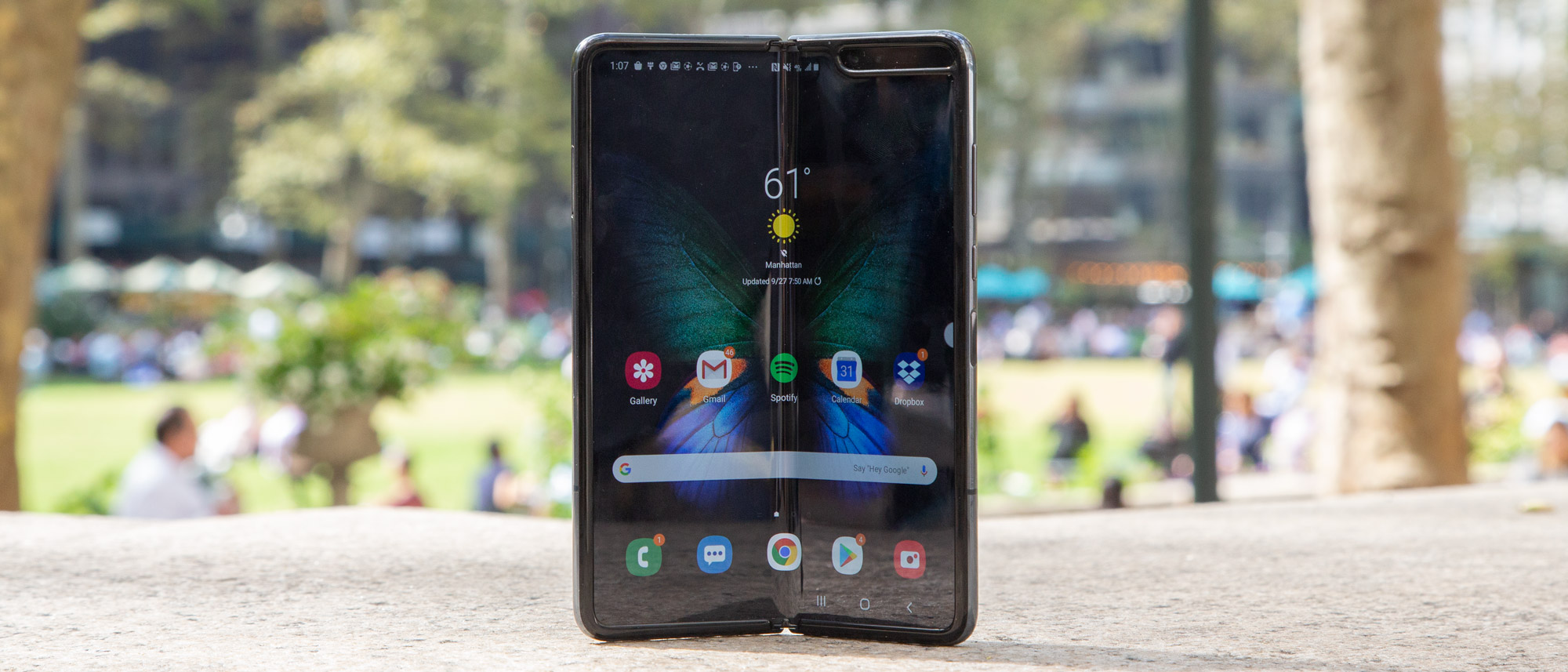Tom's Guide Verdict
The Samsung Galaxy Fold is a very innovative and exciting foldable phone, but Samsung doesn’t justify the high price for this first-generation device.
Pros
- +
Innovative folding display
- +
Can run three apps at once
- +
Dedicated customer support
- +
Included Galaxy Buds
Cons
- -
Very expensive
- -
Small front display
- -
Bulky and heavy
- -
Cameras a step behind iPhone 11
Why you can trust Tom's Guide
The Samsung Galaxy Fold is a phone that elicits mixed emotions. On the one hand, there’s the sheer wonder and excitement of holding a foldable phone — and seeing it transform from a 4.6-inch handset to a 7.3-inch tablet and back again. That excitement continues when you see an app that's running on the front screen instantly pop up on the larger display, and when you start running three apps at once on the bigger canvas.
The other emotion is trepidation. Even though Samsung has made several enhancements to make the Galaxy Fold more durable since it delayed the device’s launch, the company strongly suggests that you use a light touch when pressing on the display. Then there’s the emotional sticker shock when you realize that this phone costs nearly $2,000.
As I used the device for this Samsung Galaxy Fold review, I vacillated between all of these emotions – and kept coming back to a single question: Who is the Galaxy Fold made for? The answer is: Very brave and very well-off early adopters who are willing to live with a product that feels like a refined prototype.
Samsung Galaxy Fold review: Cheat sheet
Starting Price: $1,980
OS: Android 9.9 with One UI
CPU: Snapdragon 855
RAM: 12GB
Storage: 512GB
External display (closed): 4.6 inches (HD+)
Main display: 7.3 inches (QXGA+)
Rear cameras: 12-MP wide-angle (f/1.5 to f/2.4); 12-MP telephoto (f/2.4); 16-MP ultra-wide (f/2.2)
Front camera (closed): 10-MP selfie (f/2.2)
Front camera (open): 10-MP selfie (f/2.2); 8-MP RGB depth (f/1.9)
Fingerprint sensor: Bixby button
Colors: Space Silver, Cosmos Black
Battery: 4,380 mAh
Battery Life: 10:01
Size: 6.3 x 2.5 x 0.66 inches (62.9 x 160.9 x 17mm)
Weight: 9.48 ounces
- Samsung has durability improvements to the Galaxy Fold, including extending the top display, adding caps to the hinges, and putting a metal layer beneath the screen.
- The 7.3-inch display is very immersive and lets you run three apps on the screen at once, but the front 4.6-inch screen is quite small.
- When folded, the Galaxy Fold is considerably thicker than other phones, which means it’s best stored in a jacket pocket or purse.
- The Galaxy Fold lasted 10 hours on the Tom's Guide web-surfing battery test, which is not great, but you can save power by using the front screen for checking notifications.
- AT&T is the only carrier that is selling the Galaxy Fold directly, but you can also buy it unlocked. And that's not a bad idea; the AT&T version comes with lots of bloatware.
- A Galaxy Fold case comes in the box to further protect the device, along with a pair of wireless Galaxy Buds.
Samsung Galaxy Fold review: Price and release date
The Samsung Galaxy Fold went on sale through AT&T and Best Buy on Sept. 27, as well as through Samsung.com.
The Fold is one of the most expensive phones ever. It costs $1,980 in the U.S. and £1,800 in the U.K. (€2,000, $2,214), or about double the price of most premium flagships. (For context, the Galaxy S10 Plus starts at $999, and you can get a model with 1TB of storage and 12GB of RAM for $1,599. The iPhone 11 Pro Max with 512GB of storage costs $1,449. In essence, you’re paying about a $380 to $530 premium for the Fold’s ability to fold.
For those scoring at home, the Fold would cost you $66 per month, at least if you pay off your phone in 30 months using one of AT&T's Next plans.
Samsung Galaxy Fold review: Design
Even though this is my second go-around with the Samsung Galaxy Fold, there’s still a real Wow factor to this device. Thanks to a sophisticated, 20-part, dual-axis hinge, you can open this clamshell just like a book, transforming the Fold from phone to tablet mode.
Get instant access to breaking news, the hottest reviews, great deals and helpful tips.

The motion is fairly smooth and natural; I’ll admit I felt a bit like a secret agent as I used the Fold in public, surfing the web or watching a video and then closing the whole thing up before I walked away. But I also felt nervous that someone might try to steal the device from me.
It's worth noting that the main display is plastic, not Gorilla Glass, like the outer cover display. But Samsung has fortified the larger panel by placing a metal layer beneath the screen. (See more on the Galaxy Fold’s durability below).
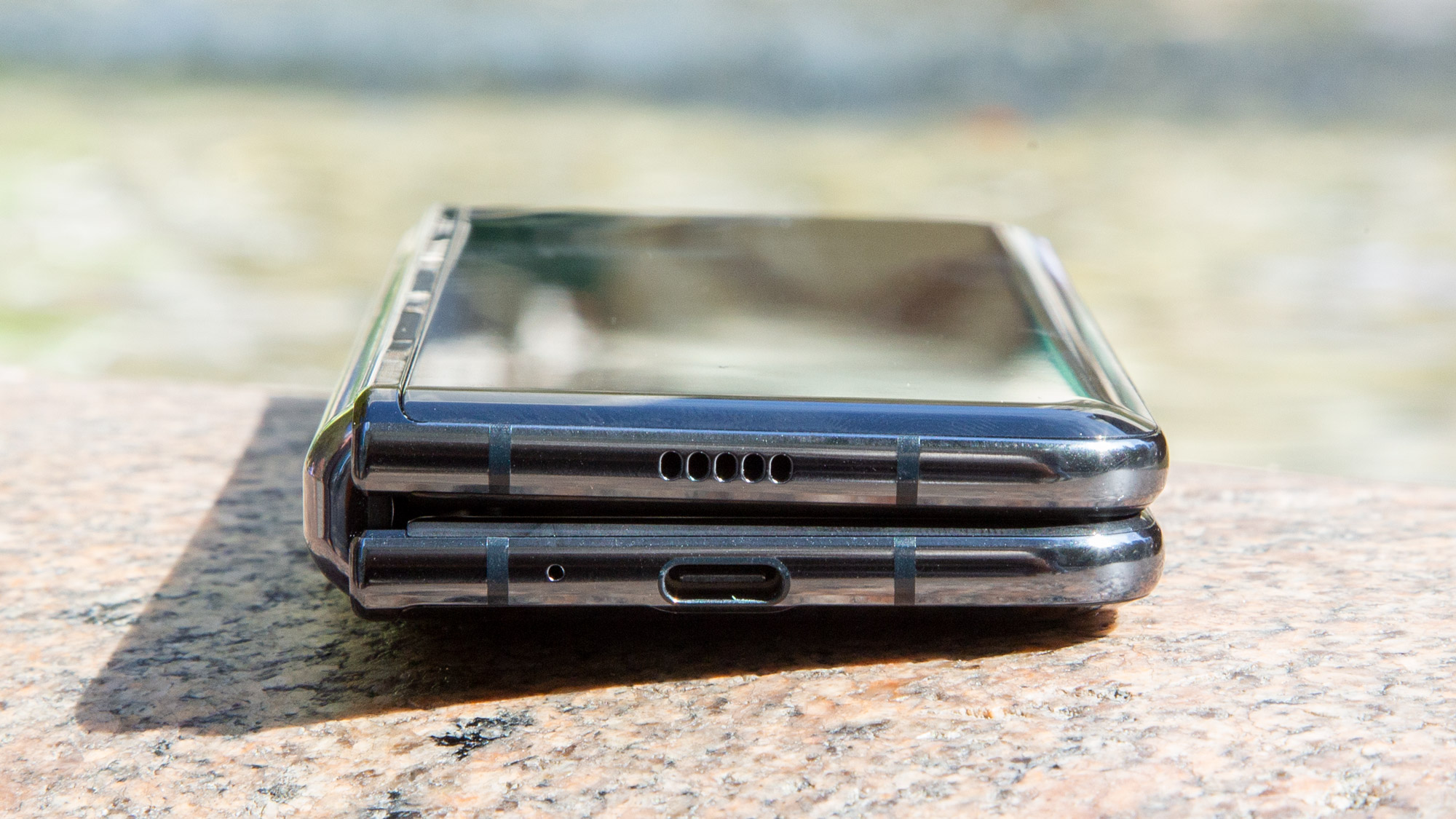
When closed, the Galaxy Fold feels like a throwback phone, and a chunky one at that. It’s quite tall and narrow, and 0.66 inches thick. That’s about double the thickness of the Galaxy S10 and iPhone 11 Pro Max. This size was not optimal for the front pocket of my pants; it’s a better fit for a blazer pocket or a purse.

The Galaxy Fold weighs a hefty 9.5 ounces, compared to 7.97 ounces for the iPhone 11 Pro Max and 6.9 ounces for the Galaxy Note 10 Plus. And I felt this weight strain my hands and forearms a bit when playing games for more than 10 minutes at a time; but if you’re watching a movie or TV show, you can lean the Fold on your lap.
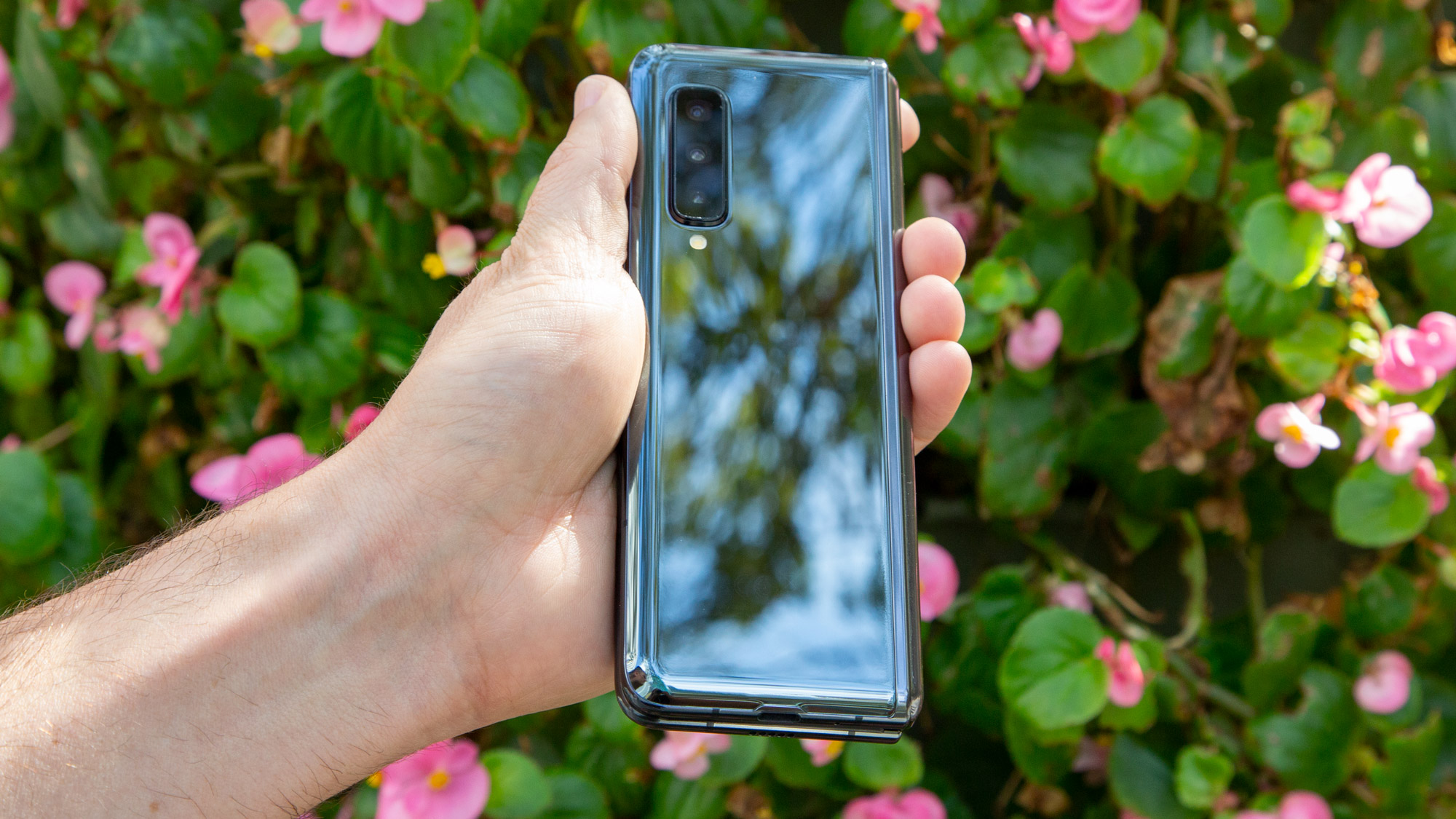
I’m not a fan of the Galaxy Fold’s button layout: Samsung decided to separate the power button and fingerprint reader on the right edge of the Galaxy Fold. It would have made more sense to combine them, which would have enabled users to power on and unlock in one fluid motion. Instead, the fingerprint sensor doubles as the Bixby button, which you can program to open other apps, as well. Even though it’s less secure, I wound up using facial recognition to unlock the Fold because it’s simply faster.

The device comes in two color options: Space Silver and Cosmos Black. That's a bummer, because Samsung was going to offer funkier colors like Astro Blue and Martian Green through its site before it redesigned the phone.
The other important thing to note is that the Fold doesn’t have a headphone jack, but this isn’t a huge deal because Samsung includes wireless Galaxy Buds in the box.
Samsung Galaxy Fold review: Durability
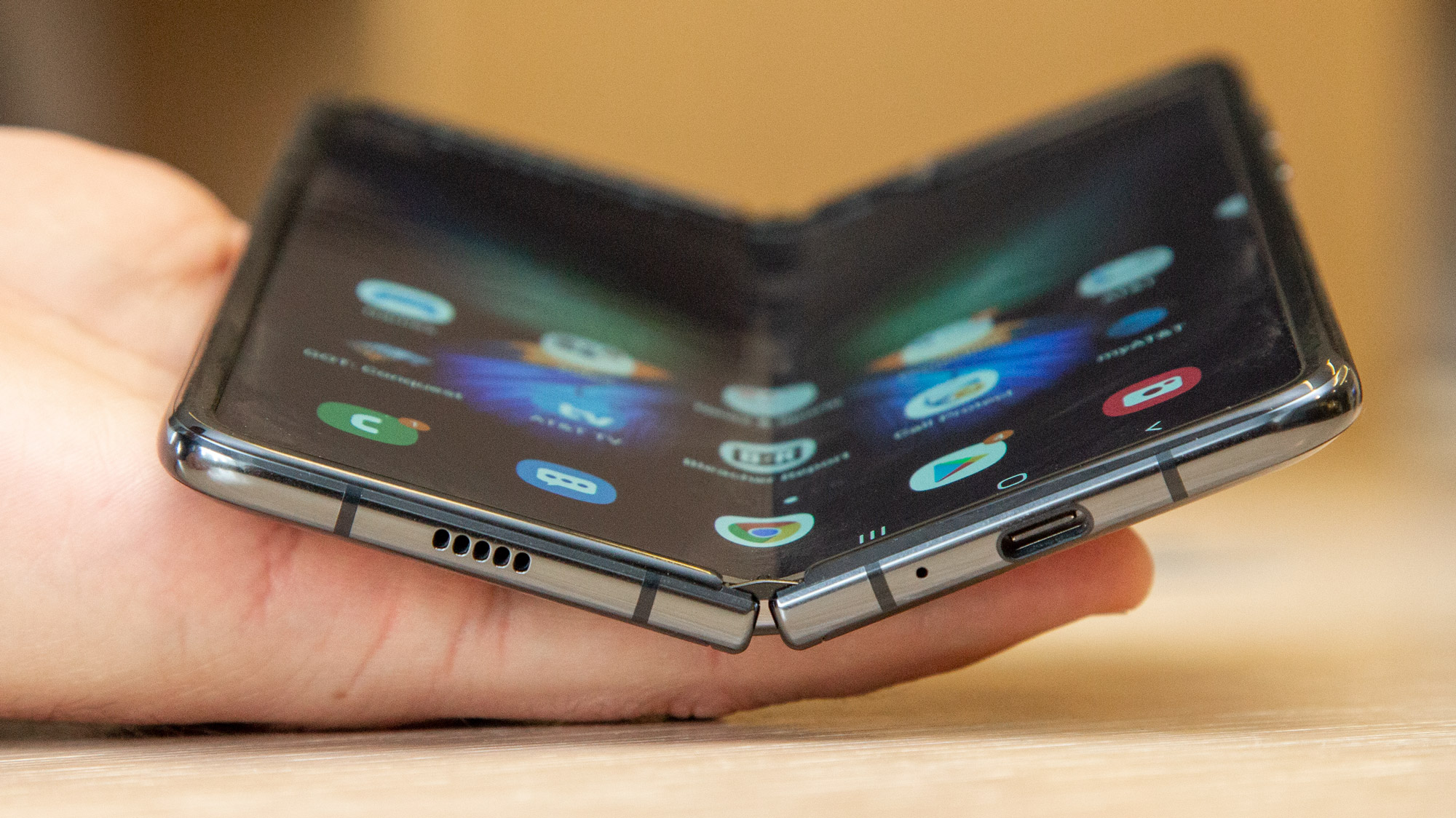
Samsung made several changes to the Galaxy Fold's design to address durability concerns before it launched for the public.
- Top display extended: Some reviewers accidentally removed this protective layer, so now it goes all the way to the edge; users are much less likely to accidentally damage the device.
- Hinges now have caps on them: This move should prevent debris from getting caught behind the screen.
- Samsung narrowed the gap between the two sides: There's still a small space for stuff to get inside the Fold when closed, but it's improved.
- Metal layer added underneath the display: This increases rigidity and makes touch interactions feel more solid.
All of these tweaks add up to a foldable that feels much closer to a $2,000 phone. Closing the phone still has a reassuring clap, like a book, and the hinge system feels pretty smooth. However, Samsung still treats this as a different class of phone when it comes to how it wants you to handle it. The company cautions that you “ use a light touch” when touching the 7.3-inch display and to keep the Fold “free of water and dust.”
One reviewer from TechCrunch reported that his Galaxy Fold was damaged after one day of use. The center of the screen became pixelated with a blob, but the cause is not clear. Thus far, we have not encountered issues with our review unit.
Samsung claims that the Galaxy Fold can withstand 200,000 opens.
Samsung Galaxy Fold review: Displays
It’s best to think of the front display on the Samsung Galaxy Fold as an at-a-glance screen for quick interactions. That’s because it’s just 4.6 inches, which is Lilliputian compared to even the best small phones (typically 5.5 inches and up). Because the screen is narrow, it’s also difficult to type on.

During my testing, I used the front display maybe 15% of the time, which included checking Gmail (but not responding), reading a news story with one hand while on the subway, and changing tracks on Spotify. Anything more made me feel that I needed the larger screen.
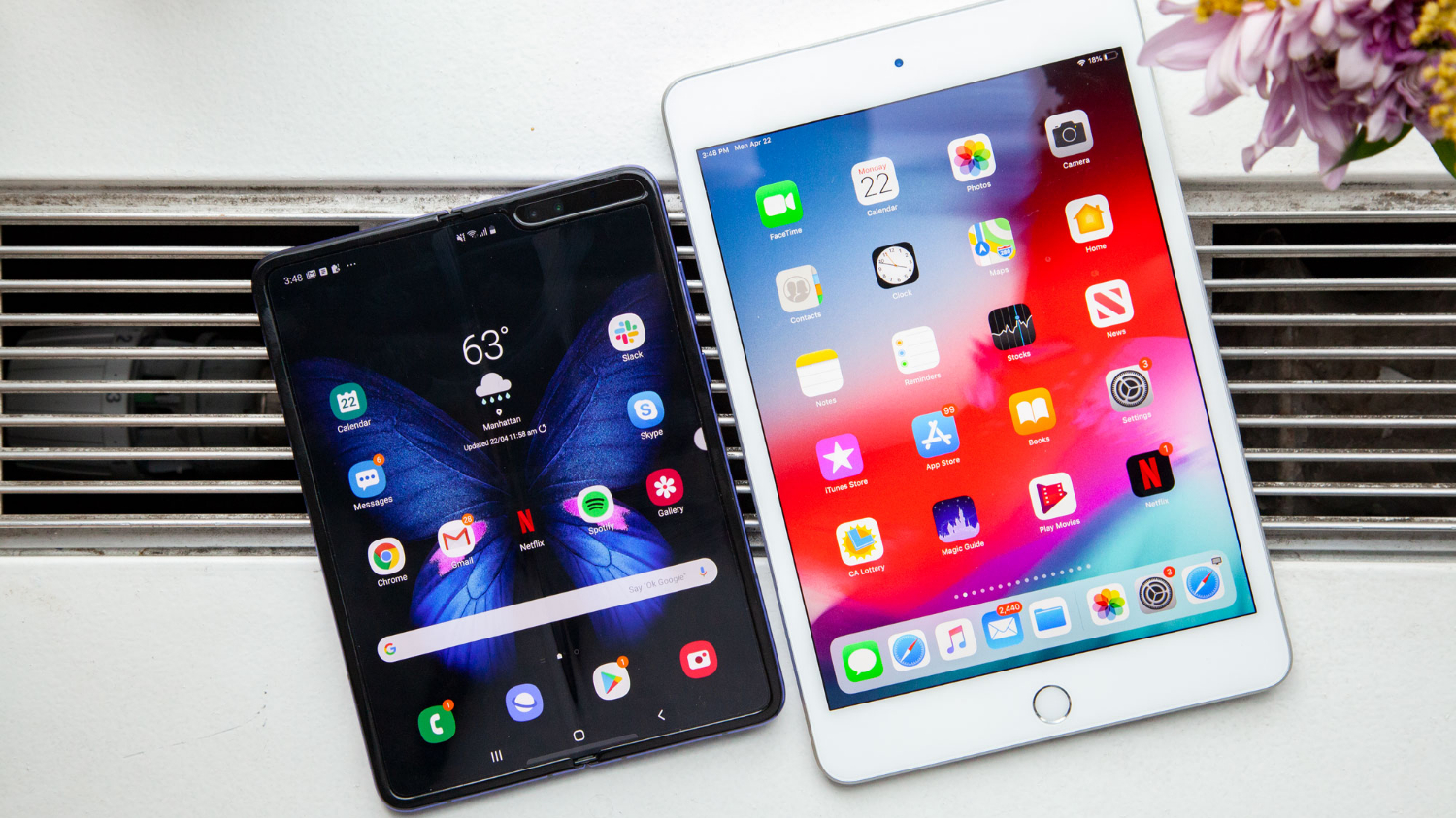
The interior 7.3-inch display is where the real action is — an oversized Super Active Matrix organic light-emitting diode (AMOLED) canvas that’s sharp and colorful but with a couple of trade-offs. On the plus side, I really enjoyed watching the Star Wars: The Rise of Skywalker trailer; it really felt like I was using a tablet. I could even access and edit articles in our site's CMS because of how wide the display is. This is something I can’t do as easily on the 6-inch-plus-size screens of the Galaxy Note 10 and iPhone 11 Pro Max.

During one commute home, I watched The Boys on the Prime Video app and felt like I had a mini movie theater in front of my eyes. If you’d rather not have big bars above and below the display you can choose which apps go full screen in the Settings app.
However, the crease in the middle of the Fold’s display is noticeable when you use apps with a white background, such as Chrome and Gmail. It’s not ugly, just distracting. And you can feel the crease when you’re using various apps. The good news is that the crease isn’t as noticeable when viewing head-on movies, photos or anything with lots of colors.
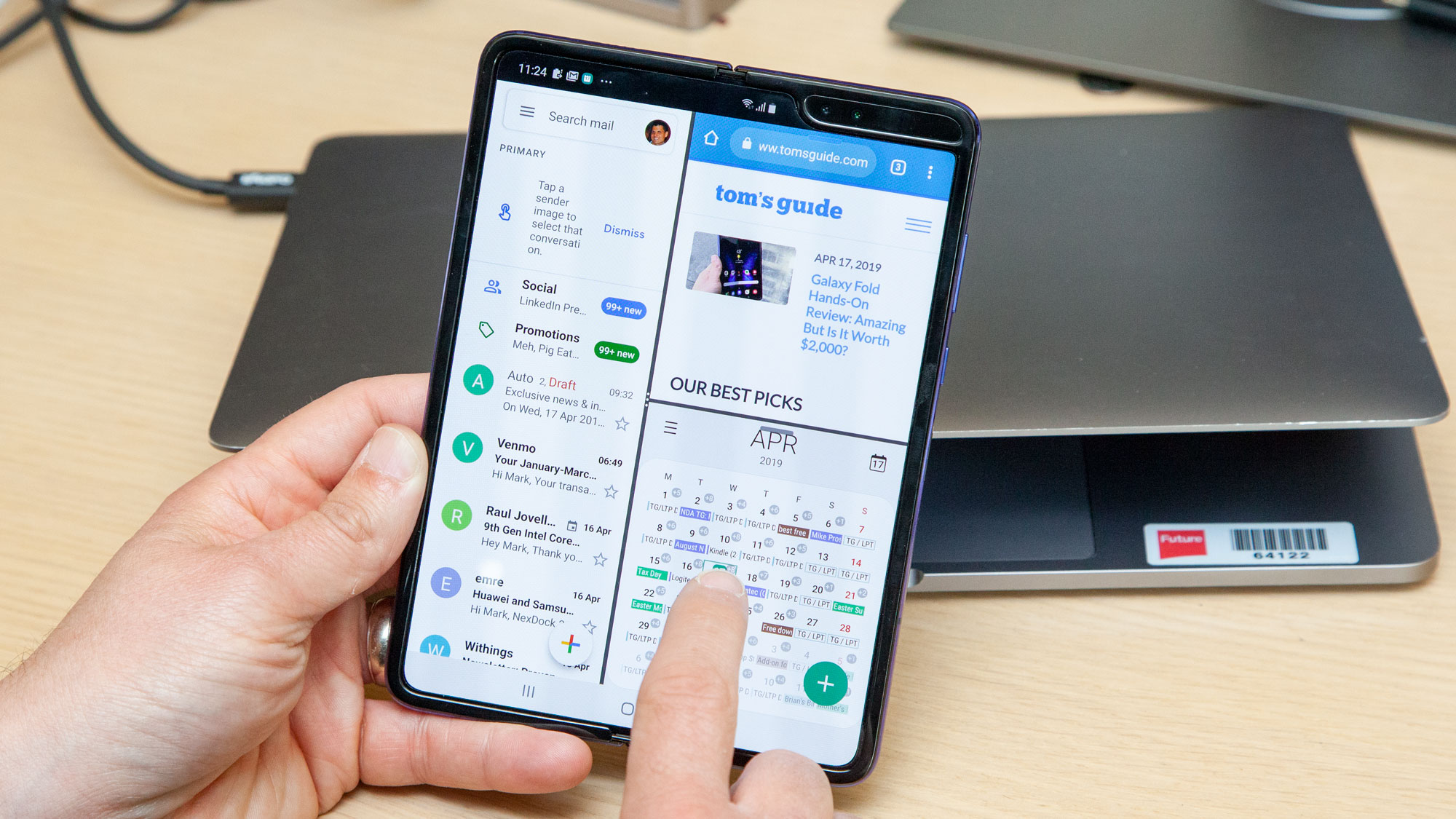
On our testing, the Galaxy Fold’s display averaged 525 nits of brightness, which is not as bright as the Galaxy Note 10 Plus (686 nits) and nowhere near as bright as the iPhone 11 Pro Max (761 nits).
The OLED panel on the Fold of the color gamut registered 124.8% of the sRGB color gamut in Natural mode, which is about the same as the Galaxy Note 10 Plus and a bit higher than the iPhone 11 Pro Max (118.6%).
The notch in the top right corner of the display can cut off videos should you decide to watch in full-screen mode; you can hide this notch by turning on an option in Software, but this just creates a black bar across the top of the screen.
My bigger problem with the Fold’s notch is that you can’t swipe down from the right side of the screen to reveal your notifications and quick settings. Instead, I had to shift my finger toward the middle of the display. However, you can also use the fingerprint sensor to open and close the notification shade with a swipe down and up.
Samsung Galaxy Fold review: Software
To make the most of its foldable design, Samsung worked with Google to devise a couple of clever software features. The first is App Continuity, which enables you to open an app on the cover display and then have the app immediately fill the larger screen when you unfold the phone.

One of the coolest features of the Galaxy Fold is App Continuity. If you're using an app like Google Maps on the front screen, you can open the display and it will instantly fill the larger display. This feature worked really well in my testing, with most apps popping up instantly.But you will need to tweak a setting if you want a given app to keep running on the small screen when you close the phone again.
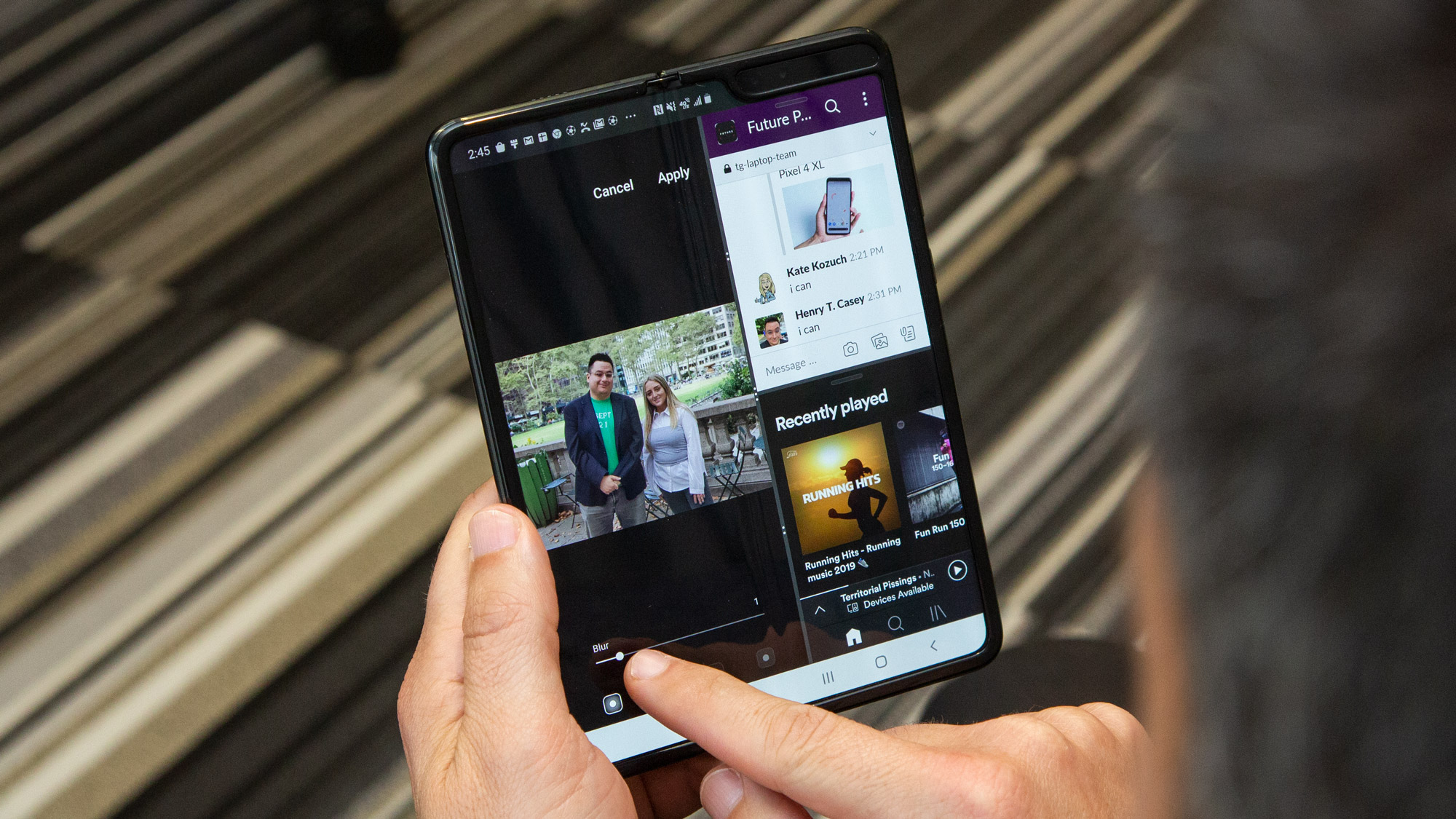
The other handy feature is Multi Active Window, which allows you to run up to three apps at once on the Galaxy Fold’s large display. You swipe in from the right side of the screen to open additional apps, and can also easily resize the apps and move them around with your finger.
A decent number of third-party apps already support this multitasking mode, such as Spotify and Slack, but I noticed that Skype does not. It will take time for more developers to update their software for foldable phones like this.
By default, the big-screen keyboard offers a split layout to speedup thumb typing on such a large canvas, but I found myself switching to a regular layout because it felt like less work. No matter which mode you choose, swipe typing is supported.
If you’re not a fan of carrier bloatware, I recommend that you buy the unlocked version of the Galaxy Fold. The AT&T model I reviewed had 19 apps from AT&T and AT&T-owned brands, including everything from DriveMode and Visual Voicemail to Bleacher Report and AT&T TV. I would prefer a much cleaner canvas for a $2,000 smartphone and I think Fold owners would, too.

Samsung Galaxy Fold review: Cameras
Having six cameras on a phone seems like overkill, but it isn’t given the Samsung Galaxy Fold’s unique design. Just like the Samsung Galaxy S10 Plus and Samsung Galaxy Note 10, there’s three shooters on the back of the Galaxy Fold: a 12-megapixel wide-angle camera, a 16-MP ultra-wide lens and a 12-MP telephoto lens.
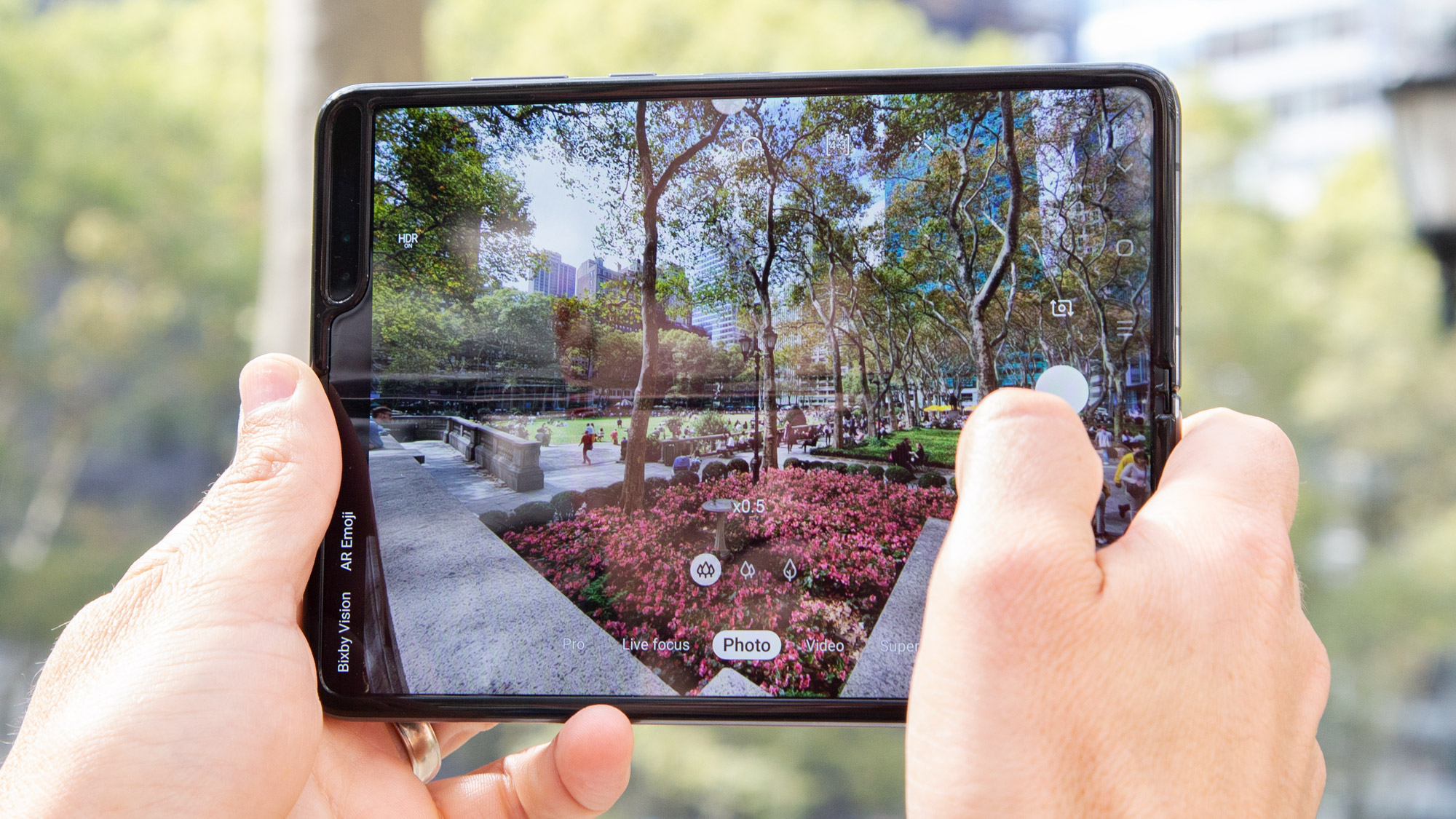
Up front – when the Fold is closed – there’s a 10-MP camera for selfies. And when unfolded, the Galaxy Fold has another 10-MP main camera plus an 8-MP depth camera for portraits.
Shooting with the Fold closed feels borderline sneaky because it’s so compact. You just double press the power button and start firing away. It’s particularly good for selfies, as you don’t have to stretch your thumb far at all to shoot.
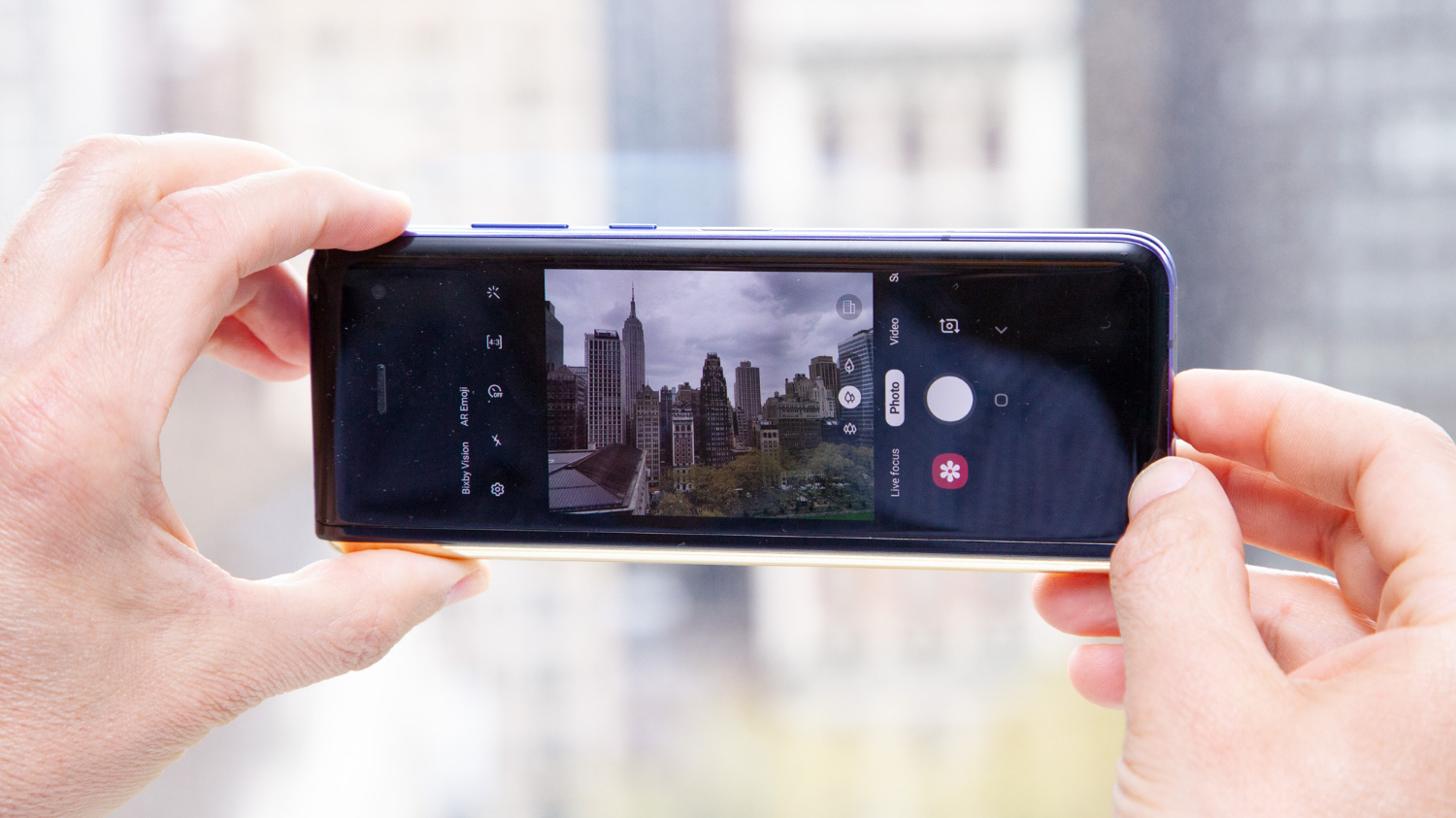
The problem is that the 4.6-inch screen is pretty small for framing shots; I found myself using the larger 7.3-inch panel when I wanted to make sure that I liked what I was capturing. Surprisingly, I didn’t find shooting with a tablet-size display in front of my face embarrassing, which is probably due to the small bezels around the screen. But, in this mode, it is a two-handed affair.
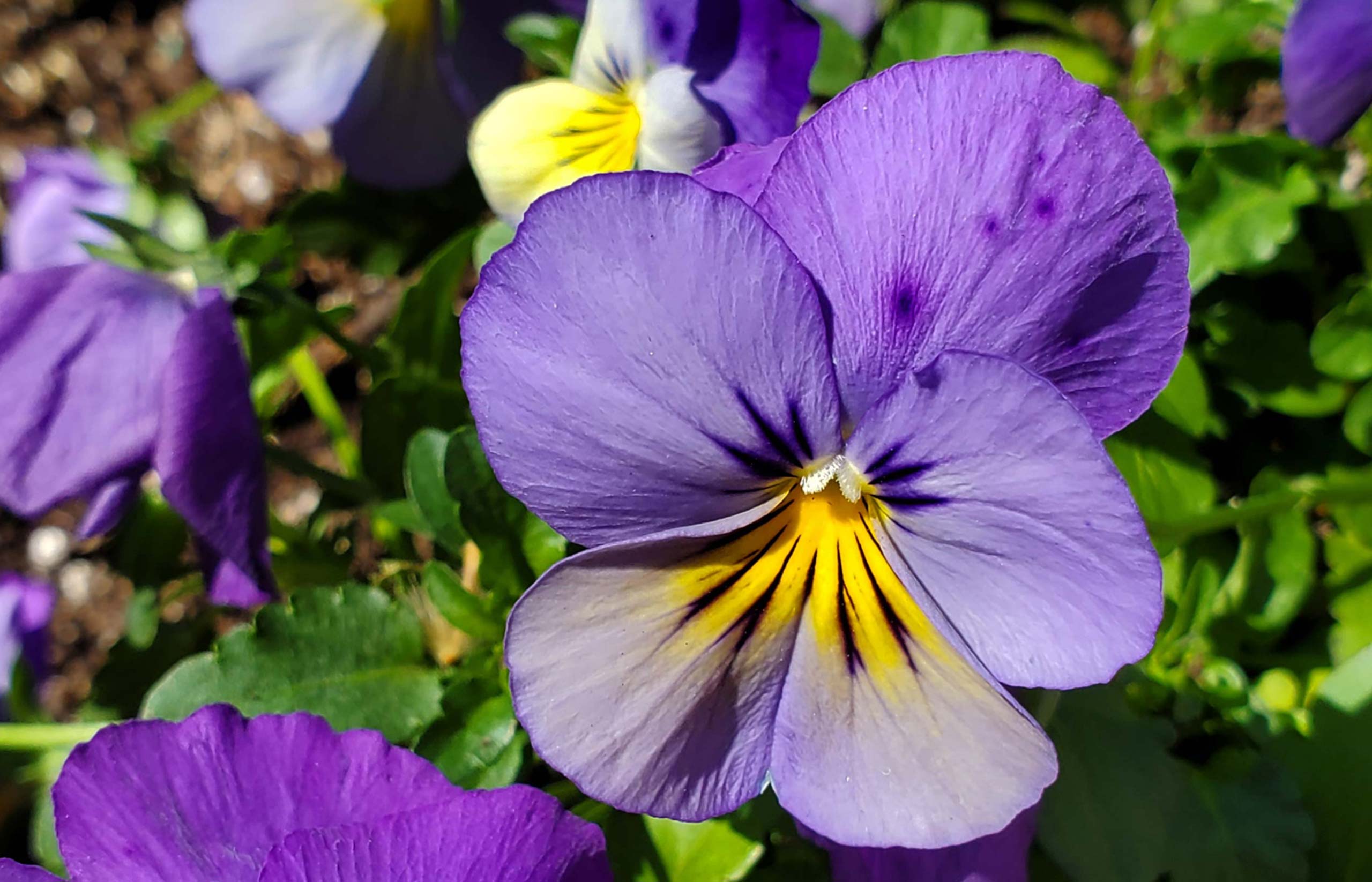


The Galaxy Fold is capable of delivering gorgeous photos with saturated color and a stunning amount of detail, as evidenced by this flower close-up. The rich purple really shines through, and the veins in the petals are well defined.
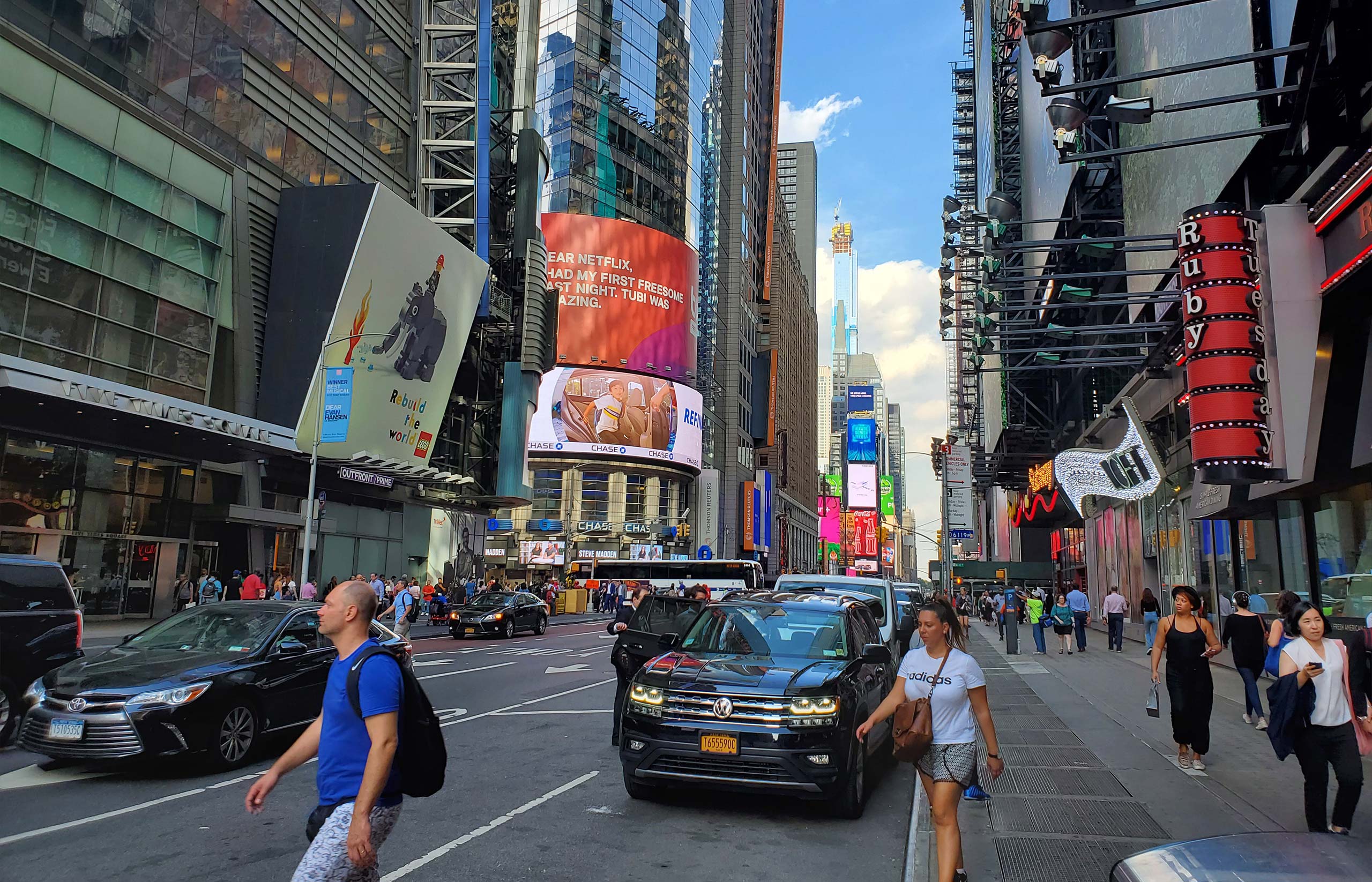
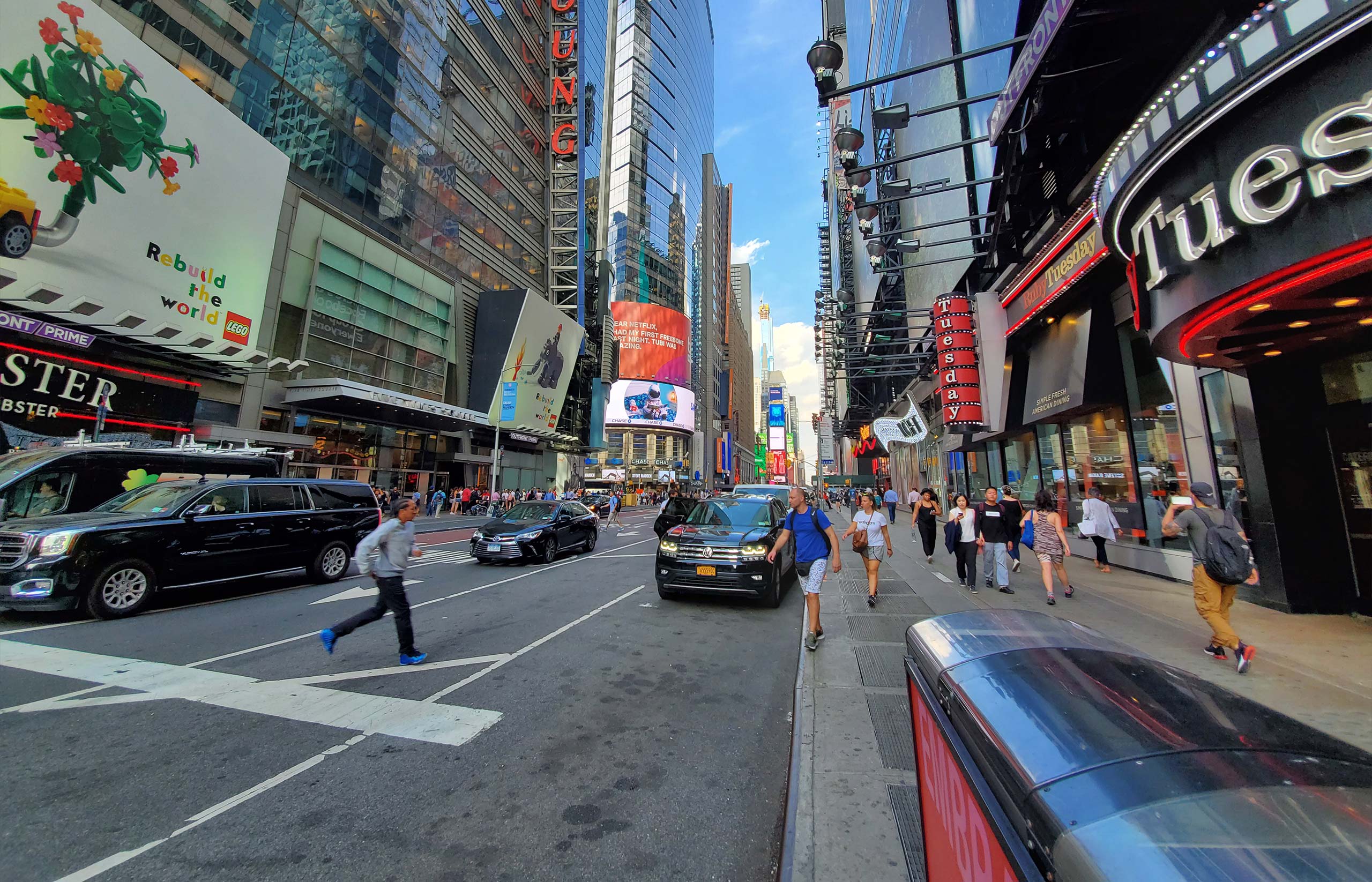

I also had fun playing with the multiple lenses in Times Square. The standard wide-angle camera captured the myriad signs with crisp detail, and I could easily make out details on the signs as I zoomed in. The wide-angle shot resulted in a noticeable fish-eye effect toward the edges, but it got a lot more of the surrounding buildings into the frame.
Like the Galaxy S10 and Galaxy Note 10, the Galaxy Fold comes with artistic new Live Focus modes, including spin bokeh, zoom bokeh and color print. I especially like the latter option, as it colorizes the main subject while leaving everything else black and white.
However, the Fold fell flat compared with the iPhone 11 Pro Max in this portrait of my two colleagues, Henry and Kate. The camera washed out both of the subjects’ faces and made Henry’s jeans look like pants. Adam Ismail, who reviews lots of phones for Tom’s Guide, said of the Fold’s shot that Henry and Kate looked like they needed medical attention. You can also make out more texture and details in Kate’s shirt on the iPhone 11 Pro Max’s shot.
The Galaxy Fold also offers a dedicated Night mode, which I put up against the Night mode of the iPhone 11 Pro Max. When I snapped a photo outside around 7:30 p.m. in almost complete darkness, the Fold produced a brighter image, as you can make out more of the tree in the foreground. The iPhone 11 Pro Max’s shot also has more of an orange cast to it, especially in the street, it's image also provides better contrast in the bricks and better detail.

The front camera on the Galaxy Fold can take sharp selfies. There’s a fair amount of detail here in my hair and in the folds in my shirt.
Samsung Galaxy Fold review: Video
The Samsung Galaxy Fold is a very capable phone when it comes to shooting video. It can record in 4K at up to 60 frames per second. And the device can shoot super steady video when you press the hand icon in the camera app.
In our footage shot near Bryant Park, the Galaxy Fold kept stead as I walked, but the camera had some trouble with the bright sunlight, as some faces looked washed out. However, the fountain looked pretty sharp, and the Fold did a good job rendering the surrounding buildings when I activated the ultra-wide camera.
When I engaged the telephoto lens on the Fold to shoot a nearby Le Pain Quotidien, I could make out small details like the Pick Up Here sign.
Samsung Galaxy Fold review: Performance
Given that the Samsung Galaxy Fold has the same Snapdragon 855 processor as the Galaxy S10 and Note 10 line of phones, it’s not a surprise that it offers comparable performance. The main difference is the whopping 12GB of RAM included in the Fold, which did seem to help juggle having multiple apps open on screen at once. I didn’t notice much lag as I ran three apps simultaneously.
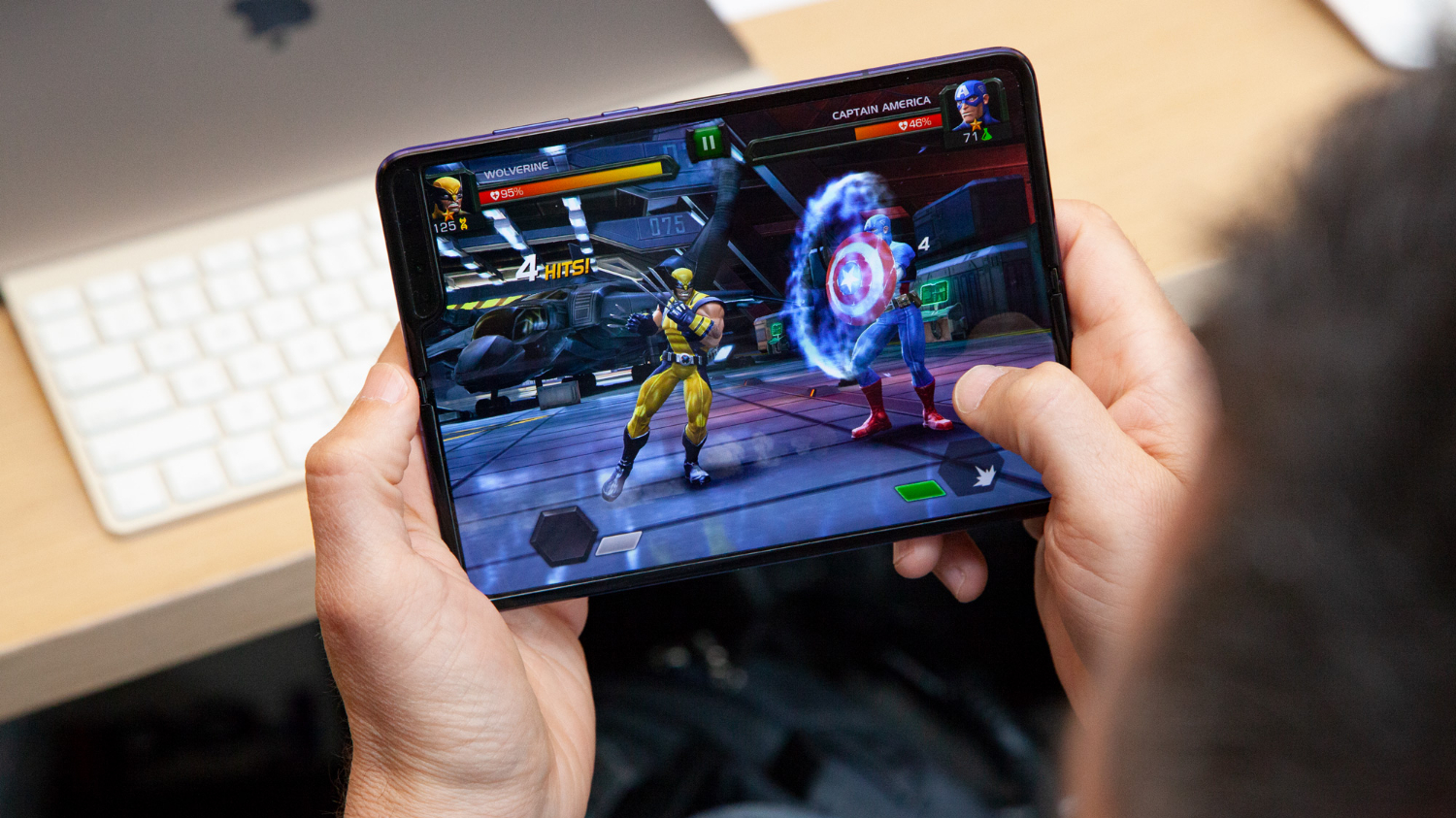
On Geekbench 5, a relatively new benchmark that measures overall performance, the Galaxy Fold scored 728 on the single-core portion of the test and 2,619 on the multi-core portion. The Galaxy Note 10 Plus scored 736 and 2,691 respectively, which is pretty much identical, while the OnePlus 7T scored a slightly higher 744 and 2,802.
The iPhone 11 Pro Max blew away the field with a single-core mark of 1,334 and a multi-core score of 3,517. We'll be running additional tests throughout our time with the device.
To gauge graphics performance on the Galaxy Fold, we ran GFXBench; the phone turned in a score 1,038 frames on the high-tier version of the Aztec Ruins Vulkan test (offscreen). The iPhone 11 Pro max notched a higher number – 1,657 frames.
Samsung Galaxy Fold review: Battery life
With a 4,380 mAh battery, the Samsung Galaxy Fold has pretty good staying power given its huge display, but other phones last longer on a charge. On the Tom's Guide battery test, which involves continuous web surfing over 4G LTE (we used AT&T's network) at 150 nits of screen brightness, the Galaxy Fold's battery lasted 10 hours and 1 minute.
This runtime is pretty good when you consider that we used the larger 7.3-inch display for the entire duration of this test. (We will be retesting where we use the smaller front display for a quarter of the time.) By comparison, the Galaxy Note 10 Plus lasted an average of 11:09 on our test, and the iPhone 11 Pro Max averaged 11:54.
- Best phone battery life: Longest-lasting smartphones
On a day with intermittent usage, which included snapping photos, streaming music, watching video clips and checking email, the phone still had 60% capacity left at 9:15 p.m; I had unplugged the phone at 6:30 a.m.
On a day when I used the Galaxy Fold more heavily, which included watching two full TV episodes on Netflix, the Fold was down to 25% come 9 p.m. That’s still more than a full day’s worth of endurance.

I loved being able to fire up the Wireless PowerShare feature on the Galaxy Fold, which allows you to charge other phones and accessories by simply placing them on the back of the Samsung handset. This includes the wireless Galaxy Buds, which Samsung throws in for the $1,980 price.
Samsung Galaxy Fold review: Verdict
The Galaxy Fold feels like a phone from the future, and yet from a practical perspective it falls a bit short. When I was using Slack in one window, Gmail in another and Spotify in yet another on the 7.3-inch screen, I could see myself using my laptop less and a device like this more. I also liked being able to review and edit large documents on the go. And it’s just cool to close the whole thing up when you’re ready to walk way.
But that doesn’t mean you should invest $2,000 of your own money. Even if you put aside the lingering durability concerns around the Galaxy Fold, I find the overall design bulky and heavy, and the front display is too small. And while the cameras are solid, the iPhone 11 Pro has leapt ahead with its better HDR and night mode.
So as much as I appreciate what Samsung has accomplished with this first-generation foldable phone, I would suggest that most people wait for the sequel and for other foldables to hit the market before they take the foldable plunge.
Mark Spoonauer is the global editor in chief of Tom's Guide and has covered technology for over 20 years. In addition to overseeing the direction of Tom's Guide, Mark specializes in covering all things mobile, having reviewed dozens of smartphones and other gadgets. He has spoken at key industry events and appears regularly on TV to discuss the latest trends, including Cheddar, Fox Business and other outlets. Mark was previously editor in chief of Laptop Mag, and his work has appeared in Wired, Popular Science and Inc. Follow him on Twitter at @mspoonauer.
